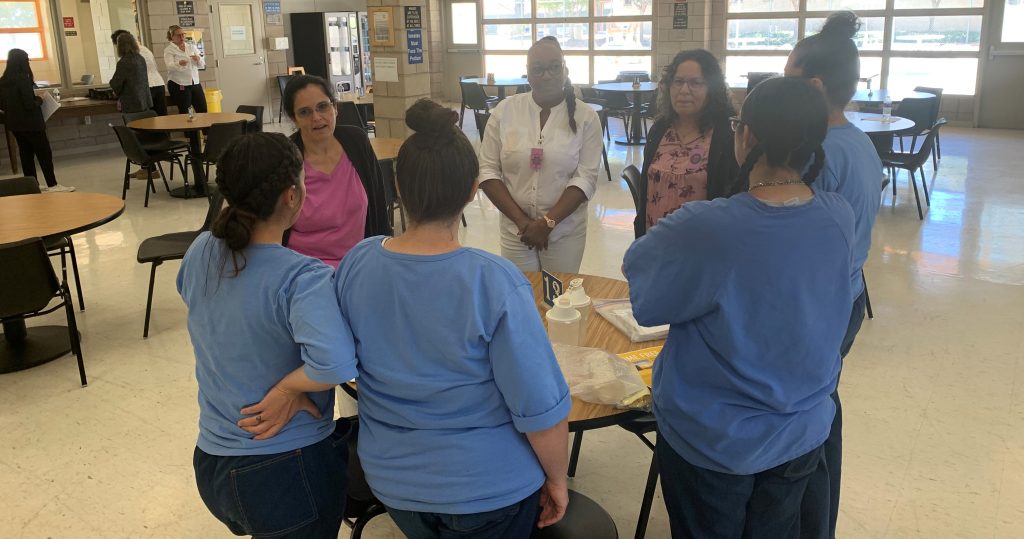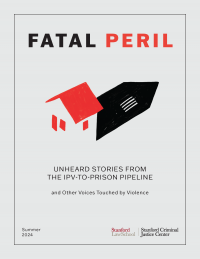In brief
- Researchers surveyed 650 women serving sentences for murder and manslaughter in two California prisons.
- Nearly three-fourths of respondents reported experiencing intimate partner violence (IPV) in the year before their offense took place. Of these, two-thirds were in “extreme danger” of being killed by their intimate partner.
- Nearly a third said that in the year before their offense, they had been strangled or choked more than once or felt dizzy, confused or blacked out after being choked—injuries that can cause a traumatic brain injury.
- The report urges the criminal legal system to take measures to more consistently screen for IPV and to better take into account how traumatic brain injuries as a result of intimate partner violence can affect survivor-defendants’ ability to remember and communicate details relating to their abuse and alleged crimes.
A groundbreaking new study provides extensive documentation of the “IPV-to-Prison Pipeline”—the pathways through which women who are survivors of intimate partner violence (IPV) find themselves serving long prison sentences for acts of survival.
The report, Fatal Peril: Unheard Stories from the IPV-to-Prison Pipeline and Other Stories Touched by Violence, is the product of a multi-year study by the Regilla Project, a research initiative of the Stanford Criminal Justice Center that focuses on women incarcerated for homicide offenses growing out of their own abuse.

Fatal Peril gives voice to approximately 650 people serving time for murder and manslaughter in two California prisons, the Central California Women’s Facility in Chowchilla and the California Institution for Women in Chino. Through surveys proctored at the prisons in July and November 2023, the researchers sought to better understand how people experiencing IPV are criminalized for actions they took to survive abuse. Stanford students contributed to the proctoring, data analysis, and drafting of the report.
A first-ever approach to IPV research
The study represents the first time the Composite Abuse Scale and Danger Assessment, two validated instruments used to assess intimate partner violence and intimate partner homicide, have been used in the study of a population who is incarcerated. In addition to quantitative results, the report presents qualitative data collected from hundreds of study respondents who shared their experiences of abuse, the circumstances of the offenses, their experiences of the criminal legal system, and their feelings of regret, remorse, and healing.

The women’s self-reported testimonies of surviving abuse are remarkably similar, according to Debbie Mukamal, executive director of the Stanford Criminal Justice Center, who led the study with Dr. Andrea N. Cimino, an expert in gender-based violence research. Cimino serves as research director and Mukamal is co-director of the Regilla Project, along with David Sklansky, Stanley Morrison Professor of Law and the faculty co-director of the Stanford Criminal Justice Center, which released a companion report in 2023. “The stories of these women reflect a persistent belief that their lives were in danger,” Mukamal said, “often from an accumulation of their intimate partner’s threats and attempts to kill them, their children, or other loved ones.”
“These are a group of forgotten women,” Cimino said. “Their experiences of violence were silenced in the courtroom and they have been neglected in IPV research which focuses on non-incarcerated populations.” She hopes the study amplifies survivor’s voices and creates change in the criminal legal system.
“Our practices of criminal blaming and punishment have long failed to take adequate account of the realities of intimate partner violence, and of the ways in which abused women can be driven to violence by their own victimization," Sklansky said. "This new report, by giving long overdue attention to the accounts of women serving prison sentences for homicide—and the high rate at which these women report extreme levels of IPV in the year prior to their offenses—underscores the pressing need for comprehensive reform in this area. It deserves urgent study from judges, prosecutors, defense attorneys, law enforcement officers, correctional officials, and policymakers.”
Our practices of criminal blaming and punishment have long failed to take adequate account of the realities of intimate partner violence, and of the ways in which abused women can be driven to violence by their own victimization.”David SklanskyStanley Morrison Professor of Law and faculty co-director of the Stanford Criminal Justice Center
The women’s stories reflect lives lived in constant fear: “I was three days at the hospital because I lost my voice because he strangled me and my neck and throat was purple with bruises. And I couldn’t talk for three days,” reported one respondent. Another said: “He had us scared, both [my children] and me, that if I told anything to the police and they arrested him, he was going to get out and kill us.”
“As we approach the 30th anniversary of the Violence Against Women Act (VAWA) this month, this new study should embolden us to do more to prevent victimization and to help those who find themselves in abusive relationships,” said retired U.S. Representative Jackie Speier, who represented California’s 14th Congressional District until 2023. “The findings—while based in California—have broad national implications for how we treat some of the most vulnerable women in our communities. Our work is far from done.”
Cory Booker, U.S. Senator from New Jersey, agreed: “This is an urgent report, and it is well timed as we mark the 30th anniversary of the Violence Against Women Act,” he said. “Most incarcerated women are survivors of sexual violence. We must do more as a society to prevent that violence and to help the survivors. Prisons cannot be substitutes for our failures to keep people safe. And for those who enter our prisons and jails, they must be places that do not compound trauma but help people heal from it. I am proud that VAWA Reauthorization includes provisions to address the specific needs of incarcerated women, many of which are highlighted through the study’s stories of women incarcerated for crimes stemming from their histories of abuse. There is a moral imperative to address the issues in this report. To fail to do so harms and implicates us all.”
‘Stark and troubling’ findings

Nearly three-fourths of respondents reported experiencing IPV in the year before their offense took place, a rate that is 10 times higher than women in the United States, according to the report. Fatal Peril acknowledges that while IPV exists for people of all genders, the researchers focused on women given their disproportionate rates of severe and lethal intimate partner abuse.
The respondents recounted physical, psychological and sexual abuse, including being hit, threatened with weapons, having partners who controlled all or most of their daily activities, and having to perform unwanted sex acts. Nearly a third of all respondents said that in the year before their offense, they had been strangled or choked more than once or felt dizzy, confused or blacked out after being choked—injuries that can cause a traumatic brain injury, according to the report.
Among the 464 respondents who were experiencing IPV, two-thirds of them were in “extreme danger” of being killed by their intimate partner, according to their Danger Assessment scores. It didn’t matter who was killed – stranger, intimate partner, child, family member, acquaintance, or friend – they all were at risk for intimate partner homicide. The data suggests that the risk of being killed due to IPV tragically extends to all of those around the survivor.
About half of respondents believed they were treated unfairly at trial due to gender, racial, and socioeconomic bias, according to the report. “Respondents who experienced IPV were more likely to perceive gender and income bias compared to those who were not abused,” said Cimino. “Harmful courtroom stereotypes like being called masterminds, femme fatales, gang members, and bad mothers triggered beliefs about the survivor-defendants’ culpability.”
“Our findings are stark and troubling, and have implications for the entire criminal legal system, from policing to parole,” Mukamal said. “It is particularly critical that the system considers the potential lethality of abuse suffered by these women and how traumatic brain injury from hits to the head and strangulation may affect survivor-defendants’ testimony and experiences in prison.”
Recommendations and IPV prevention
Kelly Savage-Rodriguez, who advocates for ending life-without-parole sentences through the California Coalition for Women Prisoners, said she “was not surprised by the findings” and was “grateful to see this new data being published.”
“The results affirm my own experiences and those of too many others who have been criminalized for surviving abuse here in California and across the nation,” Savage-Rodriguez said. “These survivors need support, not long prison sentences.”
The report makes recommendations for addressing the impact of IPV on survivor-defendants, including urging the criminal legal system to take measures to more consistently screen for IPV and to better take into account how traumatic brain injuries as a result of intimate partner violence can affect survivor-defendants’ ability to remember and communicate details relating to their abuse and alleged crimes.
The study also calls for enhanced attention to programs and policies that can prevent IPV in the first place, including strengthening access to mental health and substance use treatment to address cumulative trauma for survivors, their children, and their partners. “Cross-sector collaboration between the criminal legal system, the domestic violence response system, and child welfare systems are critical to violence prevention,” said Cimino.
The Regilla Project plans to convene a diverse set of stakeholders this Fall to identify concrete and viable legal and policy solutions to respond to the report’s findings.
For more information
About Stanford Law School
Stanford Law School is one of the nation’s leading institutions for legal scholarship and education. Its alumni are among the most influential decision makers in law, politics, business, and high technology. Faculty members argue before the Supreme Court, testify before Congress, produce outstanding legal scholarship and empirical analysis, and contribute regularly to the nation’s press as legal and policy experts. Stanford Law School has established a model for legal education that provides rigorous interdisciplinary training, hands-on experience, global perspective and focus on public service, spearheading a movement for change.